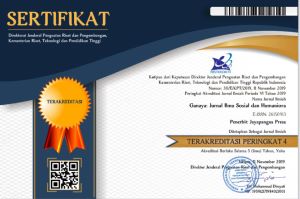Persepsi Masyarakat Baduy terhadap Konflik
Pemeliharaan Budaya dan Penyelesaian Tradisional dalam Era Perubahan
DOI:
https://doi.org/10.37329/ganaya.v6i4.2709Keywords:
Baduy community, conflict, knowledge, conflict resolution, culture, customary normsAbstract
This research explores the Baduy community in Kanekes, a traditional Sundanese community in the Kendeng Mountains region of South Banten. The Baduy community possesses distinct cultures, traditions, and social systems from the majority in their vicinity, adhering to inherited rules and norms. The study aims to investigate the Baduy community's understanding of conflicts and how they resolve conflicts based on their customary rules. The research methodology employed is qualitative descriptive, collecting data through questionnaires and structured interviews from 10 respondents within the outer Baduy community. The results show that the Baduy community possesses a sound understanding of conflicts, views conflicts as part of life, and tends to resolve them peacefully based on cultural values and customary norms. The conflicts that arise encompass romantic conflicts, psychological conflicts, conflicts with modern culture, and conflicts related to natural resources. The effectiveness of traditional conflict resolution is evident in the Baduy community's ability to maintain peace, utilize customary values as guidelines, and leverage the crucial role of traditional leaders in mediating and resolving conflicts. The Baduy community remains steadfast in their adherence to customary values in facing challenges of social change and the environment to preserve their unique culture and traditions. In-depth understanding of conflicts and the resolution methods used by the Baduy community provides valuable insights to support cultural preservation and effective conflict resolution within this community.
References
Adisti, A. R. (2018). Internalization of Javanese Unggah-Ungguh ( Etiquette ) Character in Modern Era Through Personality Course At English Education Depaertemen. Al-Ishlah: Jurnal Pendidikan, 10(2), 216–230.
Bodine, Richard J.; Crawford, D. K. (1998). The Handbook of Conflict Resolution Education. A Guide to Building Quality Programs in Schools. The Jossey-Bass Education Series. Jossey-Bass Inc. San Francisco.
Crawford, D. & Bodine, R. (1996). Conflict Resolution Education A Guide to Implementing Programs in Schools, Youth-Serving Organizations, and Community and Juvenile Justice SettingsNo Title. Program Report, 144.
Danasasmita, Saleh, dan Djatisunda, A. (1986). Kehidupan Masyarakat Kanekes. Direktorat Jendral Kebudayaan Departeman Pendidikan dan Kebudayaan.
Ekadjati, S. E. (1995). Kebudayaan Sunda : Suatu Pendekatan Sejarah. Pustaka Jaya.
Geise.J.C. Nicholas. (2022). Badujs en Moslims : Kajian Etnografis Masyarakat Adat di Lebak Parahiang, Banten Selatan. Kompas.
Gharna, Y. K. (1973). Masyarakat Baduy di Banten Selatan, Jawa Barat: Sistim Matapencaharian Hidup dan Dasar Kemasyarakatan. Universitas Padjajaran.
Jones, D. C. (2015). TEACH Journal of Christian Education Conflict Resolution for the Classroom. 9(2). http://www.examiner.com/conflict-resolution-in-madison/
Kesuma, A. S. (2013). Kerukunan Umat Beragama dan Resolusi Konflik Studi Kasus Umat Beragama pada Masyarakat Suku Baduy Perbatasan di Provinsi Banten. TAPIs, 9(2), 118–134.
Muslim, Bukhori, A. (2021). Disadvantaged but more resilient: the educational experiences of indigenous Baduy children of Indonesia. Diaspora, Indigenous, And Minority Education, 15(2), 99–112.
Nadroh, S. (2018). Pikukuh Karuhun Baduy Dinamika Kearifan Lokal Di Tengah Modernitas Zaman. Jurnal PASUPATI, 5(2), 196.
Papakitsos, E. C., & Karakiozis, K. (2016). European Journal of Alternative Education Studies CONFLICT MANAGEMENT VIA. 68–84.
Puryanto, S. (2022). Konflik, Karakter dan Pancasila: Studi Kepustakaan. Journal of Education, Humaniora and Social Sciences (JEHSS), 4(4), 2351–2360.
Sam, A, Suhandi, dkk. (1986). Tata kehidupan Masyarakat Baduy di Jawa Barat. DEPDIKBUD Proyek Inventarisasi dan Dokumentasi Kebudayaan Daerah.
Senoaji, G. (2004). Pemanfaatan Hutan Dan Lingkungan Oleh Masyarakat Baduy Di Banten Selatan (The Uses of Forest and the Environment by Baduy Community in South Banten, Indonesia). Jurnal Manusia Dan Lingkungan, 11(3), 143–149.
Senoaji, G. (2010). Masyarakat Baduy, Hutan, Dan Lingkungan. Jurnal Manusia Dan Lingkungan, 17(2), 113–123.
Senoaji, G. (2011). Perilaku masyarakat baduy dalam mengelola hutan, lahan dan lingkungan di banten selatan. In HUmaniora (Vol. 23, Issue 1, pp. 1–15).
Septiana, M. D. (2016). Perempuan Dalam Kearifan Lokal Suku Baduy. Jurnal Filsafat, 19(3), 199–213.
Simamora,Santa Lorita., Andika, Dicky., Rizki Briandana., W. (2021). Shift of Pikukuh Karuhun Values due to Communication TechnologyExposure to Baduy Society. Nyimak Journal of Communication, 5(2), 6.
Suparmini, Sriadi Setyawati, dan D. R. S. S. (2013). Berbasis Kearifan Lokal. Jurnal Penelitian Humaniora, 18(1), 8–22.
Sutendy, U. (2010). Damai dengan Alam, Kearifan Hidup orang Baduy. Media Komunikasi.
Sutoto, S. (2017). Dinamika Transformasi Budaya Belajar Suku Baduy. Jurnal Penelitian Pendidikan, 17(2).
Downloads
Published
How to Cite
Issue
Section
License
Copyright (c) 2023 Sidik Puryanto, Sardjiyo (Author)

This work is licensed under a Creative Commons Attribution-ShareAlike 4.0 International License.
An author who publishes in the Ganaya : Jurnal Ilmu Sosial dan Humaniora agrees to the following terms:
- Author retains the copyright and grants the journal the right of first publication of the work simultaneously licensed under the Creative Commons Attribution-ShareAlike 4.0 License that allows others to share the work with an acknowledgement of the work's authorship and initial publication in this journal
- Author is able to enter into separate, additional contractual arrangements for the non-exclusive distribution of the journal's published version of the work (e.g., post it to an institutional repository or publish it in a book) with the acknowledgement of its initial publication in this journal.
- Author is permitted and encouraged to post his/her work online (e.g., in institutional repositories or on their website) prior to and during the submission process, as it can lead to productive exchanges, as well as earlier and greater citation of the published work (See The Effect of Open Access).
Read more about the Creative Commons Attribution-ShareAlike 4.0 Licence here: https://creativecommons.org/licenses/by-sa/4.0/.








